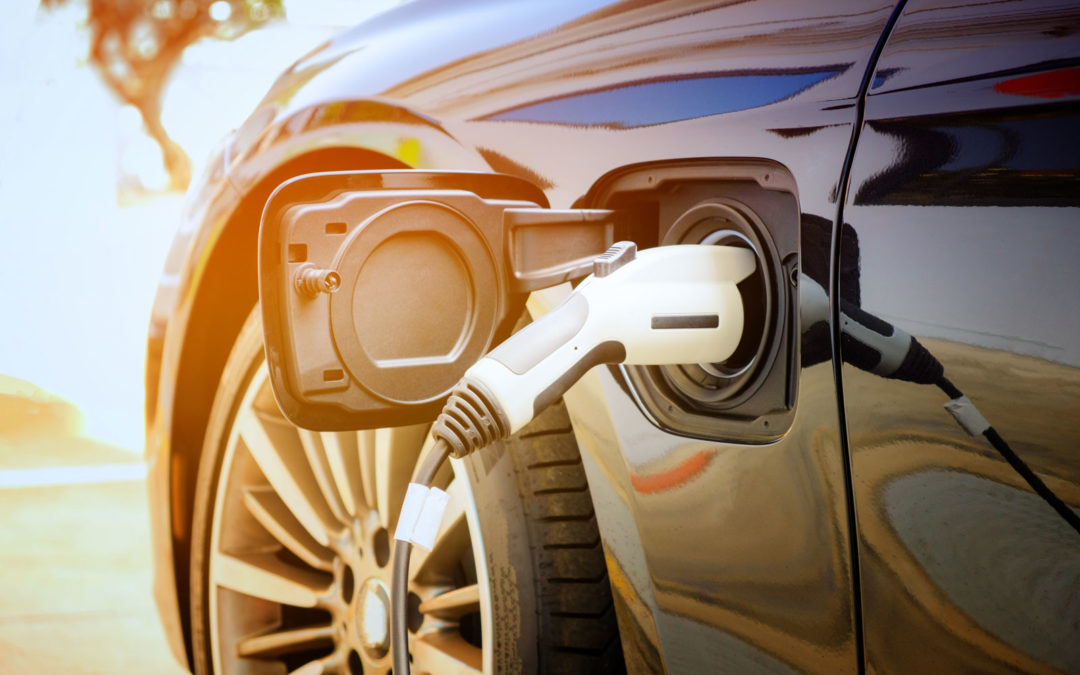
by Jane McCurry | Mar 6, 2019 | Electric Vehicles, Policy
Last fall, I wrote a blog about the Volkswagen Mitigation Settlement, A Big Opportunity for Electric Vehicles. The Federal Volkswagen Mitigation Trust awarded Wisconsin $67.1 million to replace aging diesel vehicles. The goal of the settlement is to counteract the damage done while over-polluting Volkswagen cars were in operation.
Wisconsin’s plan for spending approximately two-thirds of the funding, or $42 million, included replacing transit buses and state fleet vehicles. Now, it’s time to decide what to do the last third of that funding, about $25 million.
Good News!
Governor Evers released his State of Wisconsin Budget in Brief last Thursday. Good news! It included an allocation for the rest of Volkswagen Settlement funding, with a specific call-out for $10 million to fund electric vehicle charging infrastructure in Wisconsin. The budget calls for the $10 million to be administered as a grant program by the Department of Administration.
This is a big win. Per the settlement terms, states are allowed to use up to 15% of their funding to pay for electric vehicle infrastructure, which comes to just about $10 million in Wisconsin. Taking full advantage of this opportunity means Wisconsin drivers can drive with the confidence that they can recharge in public if they need to. This funding will go a long way to support a vast network of fast recharging stations across the entire state.
The rest of the funding, $15 million, was earmarked for more transit bus replacements. Our hope is that these buses will be electric. Electric buses are so much cheaper to operate, more efficient, and produce zero point-source pollution, making them a “win” for everyone.
What’s Next?
Before these Volkswagen allocations can be spent, the budget needs to pass through the legislature. While there is a chance that this budget will not pass, I am really excited to see a commitment to electric transportation. If this commitment makes it through the legislature, Wisconsin will join 44 other states that have also pledged to take advantage of this opportunity.
It’s a long road to ensure every Wisconsinite has access to affordable and clean transportation. This is a big step on that journey. Stay tuned for more details as we continue to follow the Volkswagen Mitigation Settlement and advocate for using Wisconsin’s funds to advance electric transportation.
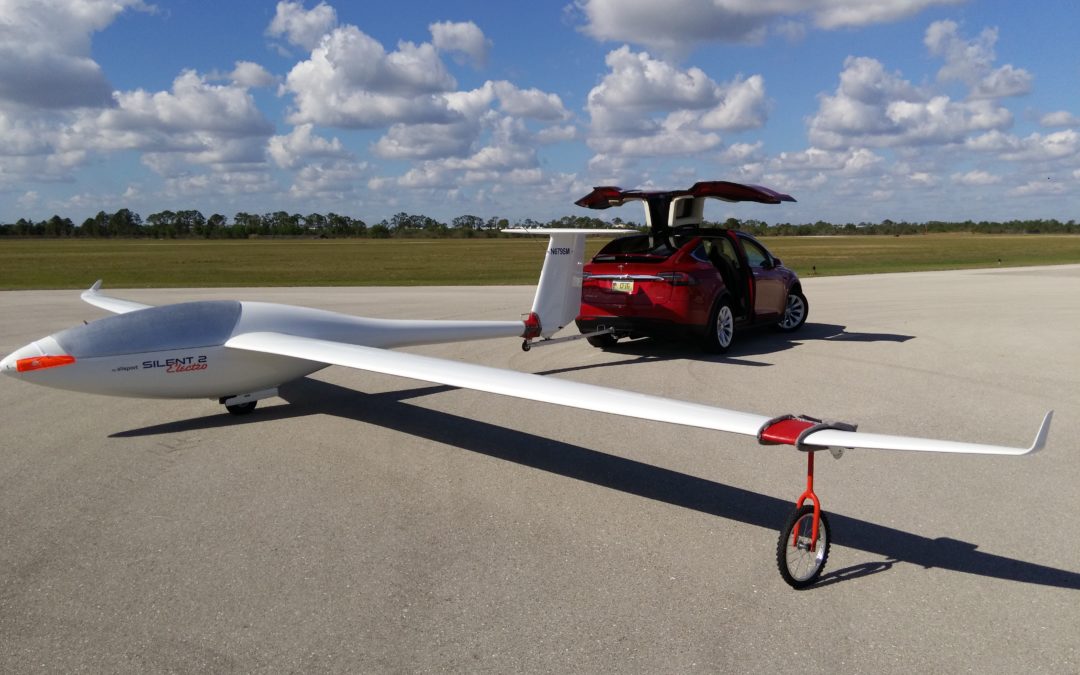
by Jane McCurry | Feb 20, 2019 | Electric Vehicles
I met Scott Manley at a National Drive Electric Week event back in September, at a Ride-n-Drive that featured his Tesla Model X. Scott’s Tesla caught my eye, but after talking with him for a few minutes, I realized that owning a Tesla was far from the most interesting thing about Scott.
Scott is a pilot and his personal aircraft is special in that it is an electrically self-launching glider. Pure gliders don’t have a propulsion system. Instead, they are typically pulled into the air by a powered airplane until they’re high enough to reach a source of rising air. Much like hawks, gliders then stay aloft using that rising air.
Scott’s glider has an electric motor, which means it doesn’t need to be towed into the air. His glider is capable of taking off under its own power and climbing into the rising air. Once there, the motor is shut down, the propeller blades fold against the side of the glider, and the flight continues, often for hours at a time, using only the energy in the atmosphere; free, clean energy generated by the sun heating the ground.
The image above shows the Tesla Model X ready to tow Scott’s Alisport Silent 2 Electro out to the launch area. The beautiful cumulus clouds in the background are each the result of a rising column of air. Way cool.
Scott is also an F.A.A. (Federal Aviation Administration) certificated glider flight instructor providing both aircraft-based and simulation-based flight training at-a-distance (via the Internet) to glider rating candidates nationwide. Learn more about him at gliderCFI.com.

by Jane McCurry | Feb 6, 2019 | Electric Vehicles, Events, RENEW Wisconsin
January was a busy month bopping between energy summits. On January 17th we had our Renewable Energy Summit in Madison and January 24 – 25 the Wisconsin Academy of Sciences, Arts, and Letters held the Powering Local Leadership Summit in Appleton.
Both summits had electric vehicle panels, and both were awesome.
Renewable Energy Summit: Electric Vehicles
This was the first time we had an electric vehicle session at the Renewable Energy Summit. Our space ended up being standing room only so I’d say it was a success. We emphasized the benefits that electric vehicles provide, no matter what business you are in.
Dan Steinhart and Mike Cornell kicked off the presentations, representing Arch Electric EV, the recently incorporated subsidiary company of Arch Electric. Arch Electric EV will house their electric vehicle charging station business. Arch is primarily a solar photovoltaic (PV) installer that has recently been in contact with over 100 businesses to gain a better perspective on the market and demand for electric vehicle (EV) recharging infrastructure. Their motto is that PV + EV = Sustainable Transportation.
Becky Cooper from Bounce Milwaukee shared her family business’s experiences with pizza delivery electric vehicles. In addition to providing family-fun of all kinds, Bounce Milwaukee owns electric Leafs that they use to deliver pizzas. Their rooftop solar array and electric pizza ovens mean their pizzas are both made and delivered on sunshine. Bounce Milwaukee uses electric cars because they’re affordable, efficient, and provide a better customer experience, in addition to boosting their brand as an early adopter of clean energy technology!
We also heard from Mahanth Joishy about the City of Madison’s commitment to low emission transportation. The city currently owns 3 Chevy Bolts and acquired a grant to purchase 20 more in 2019 and 2020. Additionally, the city has a biodiesel pilot project, 6 hybrid police vehicles, anti-idling technology on ambulances, is working on specs for compressed natural gas (CNG) trucks, and is outfitting vehicles with GPS tracking to even further optimize routes and decrease fuel use.
This session was a really excellent exercise in seeing the various ways that electric transportation can benefit all different kinds of organizations. From companies already invested in the energy transition to local family-centric businesses, and even local governments, there’s a lot to be gained from electric transportation.
Check out the slides and audio to learn more.
Powering Local Leadership Summit: Preparing Your Community for Electric Transportation
The Powering Local Leadership session had a more focused goal: provide local leaders the tools to prepare their communities for the transition to electric transportation. I kicked things off with an overview of the myriad of benefits of electric vehicles (to name a few: cheaper to operate, no tailpipe pollution, quiet, fun to drive, and convenient to refuel).
Ashwat Narayanan from 1000 Friends of Wisconsin reiterated the point that electric vehicles can solve many problems. They are not, however, a magic bullet to solving all of our transportation issues. We have to prioritize people – bikers, bus riders, and car sharers – over actual cars.
Jeff Springer from Dairyland Power Cooperative emphasized that electric vehicles have both an awareness issue and a rural issue. We need to help electricity coops through the process of getting the word out about electric vehicles, transitioning their fleets, and installing charging stations in their area. Rural solutions are also necessary – pickup trucks, SUVs, and farm equipment – all of which is coming to the market soon.
Finally, Peter Skopec from WISPIRG gave hope that with sales at an all-time high, communities really do need to be preparing for thousands of electric vehicles on their streets soon. The charging infrastructure needs to be built out, especially for folks who live in multifamily units and urban areas without access to overnight charging.
The audience had great questions that ran the gamut from gas station interest in electrification (there is some interest), to Volkswagen Settlement Funding (a huge opportunity for building electric vehicle infrastructure), and if mechanics need additional training to work on electric cars (yes, we want mechanics to be comfortable working on these cars).
I learned a ton from moderating these panels! Thanks to the panelists for joining me, and thank you for reading about them here. For those of you who couldn’t make it, I hope you can join us next year!
by Jane McCurry | Jan 23, 2019 | Electric Vehicles
Back in October I wrote a blog, Momentum is Building, about the hundreds of new electric cars that will hit the market in the next few years. Then, in the last blog I talked about how the market for electric cars in the US is exploding, up 80% from 2017. The result? Lots of electric cars coming to market in 2019.
Now, we have a preview of cars that will arrive in 2019. I read almost a dozen articles that previewed the 2019 electric car market. Here is my summary, thanks in large part to Green Car Reports.
2019 Electric Car Preview
2019 Hyundai Kona Electric
When: Any day
Range: 258 miles
Price: $37,495
What’s cool: Finalist in Green Car Reports’ Best Car to Buy competition for 2019.
2019 Kia Niro EV
When: Expected in February
Range: 239 miles
Price: $38,000
What’s cool: Completes the line-up of ecofriendly Niro models by joining the hybrid and PHEV models.
2019 Nissan Leaf Plus
When: Spring 2019
Range: 226 miles
Price: ~$30,000
What’s cool: Improved acceleration and faster charging means this isn’t your typical Leaf
2019 Audi e-tron quattro
When: Second quarter 2019
Range: 248 miles
Price: $75,795
What’s cool: Another electric SUV!
2020 Porsche Taycan
When: Late 2019
Range: 300 miles
Price: $90,000
What’s cool: Can receive 240 miles of charge in only 10 minutes
Additionally, the 2019 Volkswagen ID will arrive in late 2019, but it’s only slated to appear in Europe.
Ford will also have a 2020 electric SUV, which is rumored to have a 300-mile range. More details could be announced in 2019, though the vehicle is not likely to be available for purchase before 2020.
Other models that may be out by the end of the year include: The 2020 Kia Soul EV, 2020 BMW iX3, 2020 Mercedes-Benz EQC, 2020 Polestar 2 and 2020 Mini Cooper Electric. Details are scant so far, but I’ll keep you updated if I hear more about pricing, range, or if/when they’ll be available in the US.
My Analysis: We’re moving in the right direction
Folks who have been waiting for an electric SUV or another option for an electric car should be extremely excited by these new options! The Chevy Bolt and Tesla Model 3 now have real competition from several vehicles with comparable range and prices, like the Kona, Niro, and Leaf Plus.
My concern is the lack of lower priced options. However, if the Leaf Plus does end up coming in near $30,000, then prices are moving in the right direction. Still, that’s a fairly expensive car. Electric vehicles need to be accessible to the average car buyer in order to reach market penetration. We aren’t quite there yet, but I’m hopeful we will be soon.
As first and second-generation electric car drivers swap their ride for one of these new options, it will put more used electric vehicles into the market. These cars will have a lower upfront price, making them more accessible for the average car buyer. More on this topic in a future blog post.
Until then, head to your local dealer and test drive some electric vehicles. Let me know how it goes!
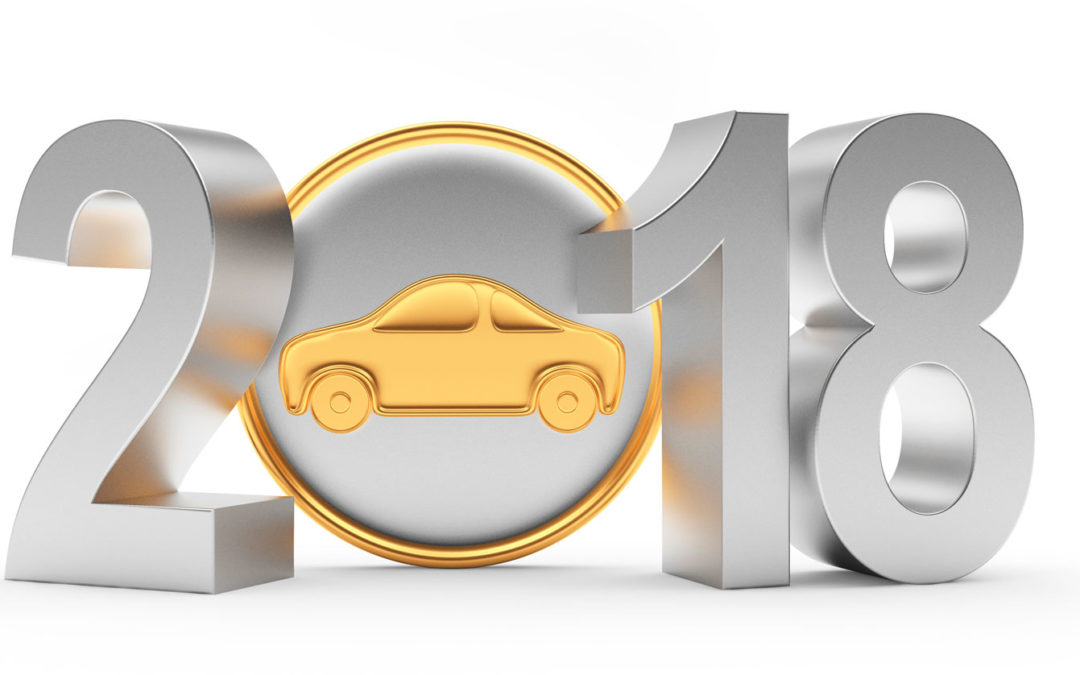
by Jane McCurry | Jan 9, 2019 | Electric Vehicles
2018 was a year of tremendous growth in the electric vehicle market. We saw new electric cars released (and one of our favorites get cancelled), two manufacturers hit the 200,000-vehicle tax credit cap, and across the county we hit record sales numbers. A few highlights include:
It’s safe to say the electric vehicle market is officially on the rise. We ended the year with 361,307 electric cars sold across the country, making up 6% of all passenger car sales!
2 Manufacturers Hit Tax Credit Cap
Tesla and GM have both sold over 200,000 electric vehicles. A great start down the adoption curve for electric cars, but also a signal that customers won’t receive their full tax credit on these cars any more.
After a manufacturer has sold 200,000 electric vehicles, the consumer tax incentive is reduced for that manufacturer’s vehicles. The full tax credit, $7500, remains for the rest of the quarter in which they hit the cap, plus the next quarter. After that, the tax credit is halved for 6 months, then halved again for the next 6 months, before expiring entirely.
Tesla hit the 200,000-vehicle cap in July, 2018 so their tax credit went from the full $7,500 to $3750 on January 1. From July 1 to the end of the year it’s halved again, to $1,875. Tesla buyers won’t see any tax credit in 2020.
GM hit the 200,000 mark in December, 2019 due to their all-electric Chevy Bolt and popular, although discontinued, plug-in hybrid, the Chevy Volt. GM vehicles can receive the full credit until March 31st. From April 1 to September 30 buyers will get the halved credit of $3750, and then $1875 until March 31st 2020.
Tesla made for a record-setting December
In December, 49,900 electric vehicles were sold – 10% of passenger car sales that month! 50% of those sales were thanks to the Tesla Model 3. Tesla pushed hard for customers to order their car before the end of the year because of the tax credit deadline. They went so far as to keep stores open until midnight on New Year’s Eve to get as many customers into inventoried vehicles as possible.
What it means for 2019
2019 is an excellent year to go electric, especially if you have your eye on a Tesla or GM model and want to capitalize on the tax credits. Manufacturers have been pushing to extend the tax credits, though with limited success. Their reason being that it’s unfair to penalize the manufacturers that are first to market by reducing the consumer incentive to purchase their vehicles. And I agree – why punish the innovators? I’m expecting to see more activity around the subject in 2019.
There are also a number of new electric vehicles coming to market. Hopefully we’ll see more SUV and truck options hit the streets in the next few months. From Kia and Hyundai, to BMW and newcomers like Rivian and Faraday Future, it’s shaping up to be an exciting year for electric car debuts.
In the next blog, I’ll do roundup of new models that will be available in 2019.
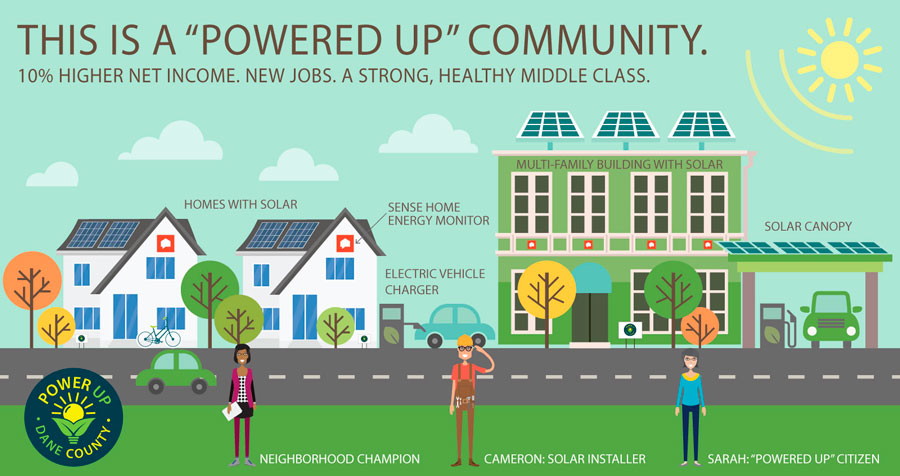
by Jane McCurry | Dec 3, 2018 | Electric Vehicles, Jobs, Programs, Renewables, Solar, Sustainability
Over the past three months, RENEW Wisconsin has been participating in an exciting and audacious challenge to develop ways to bolster the middle class of Dane County. UW-Madison was selected as one of four universities nationally to participate in a competition sponsored and funded by the Schmidt Futures Foundation, led by Google’s former CEO Eric Schmidt. UW’s program is called “Dream Up Wisconsin.”
The challenge is to increase the net income of 10,000 Dane County Families by 10%.
Our Plan: to “Power Up” Dane County families and communities with clean energy! We were one of 46 original applicants, and we were fortunate to be one of 11 applicants to receive $10,000 to more fully flesh out our proposal.
Our vision for Power Up Dane County is to create buzz about clean energy and provide community members the tools to adopt clean energy to reduce their monthly bills, create new jobs, and build a healthier community. We want everyone to have access to clean energy, from efficient homes to solar panels on their roof, and electric vehicles in their garage.
However, many middle class families don’t know that these technologies are available to them. Power Up is our idea to change that.
The program would start by empowering households to take control of their electricity bills using “Neighborhood Champions.” These champions will be excited members of the community who will help households install efficiency kits and the home energy sensor, Sense. Sense measures electricity consumption in real-time, and gives users a visual indication of their energy use through an app. By learning which devices in their home use the most electricity, residents can unplug energy hogs and save money.
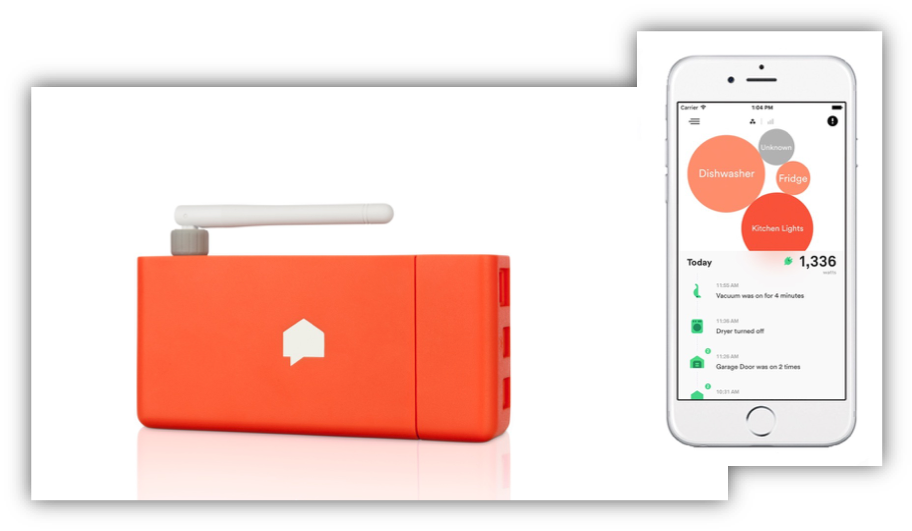
After they have more efficient homes and a better understanding of their energy use, we want to connect participants with solar installers, home weatherization technicians, car dealerships that specialize in electric vehicles, and additional rebates for their clean energy investments.
Power Up will make it desirable, easy, and financially feasible for participants to adopt clean energy, like solar panels and electric cars. These clean energy technologies will reduce air pollution and save families thousands of dollars per year on their energy bills.
Power Up is competing against 11 other proposals for the top 3 spots. Should we be selected for the next round of competition, we will pitch our proposal to Schmidt Futures in Arizona in late January.
We believe in a future that is “Powered Up” with clean energy technology. That future includes millions of dollars of in energy bill and healthcare savings, new clean energy jobs, and a healthy and prosperous middle class. The momentum around clean energy is building by the day. With Wisconsin utilities, counties, and municipalities committing to 100% renewable energy, we know the future of Wisconsin will be one with extensive clean energy adoption. Power Up is one vision for how to get there.






